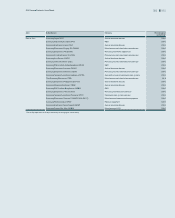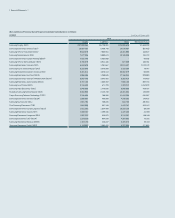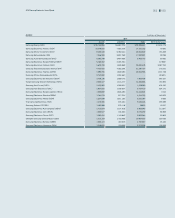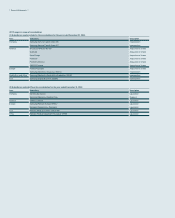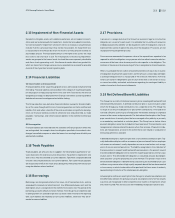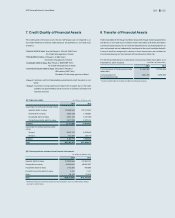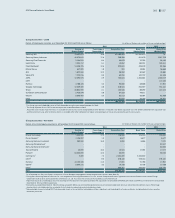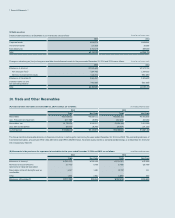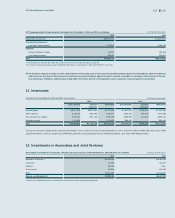Samsung 2014 Annual Report Download - page 61
Download and view the complete annual report
Please find page 61 of the 2014 Samsung annual report below. You can navigate through the pages in the report by either clicking on the pages listed below, or by using the keyword search tool below to find specific information within the annual report.
059058
2014 Samsung Electronics Annual Report2014 Samsung Electronics Annual Report
2.13 Impairment of Non-Financial Assets
Goodwill or intangible assets with indefinite useful lives are not subject to amorti-
zation and are tested annually for impairment. Assets that are subject to amortiza-
tion are reviewed for impairment whenever events or changes in circumstances
indicate that the carrying amount may not be recoverable. An impairment loss
is recognized for the amount by which the asset’s carrying amount exceeds its
recoverable amount. The recoverable amount is the higher of an asset’s fair value
less costs to sell and value in use. For the purposes of assessing impairment,
assets are grouped at the lowest levels for which there are separately identifiable
cash flows (cash-generating units). Non-financial assets other than goodwill for
which an impairment charge was previously recorded are reviewed for possible
reversal of the impairment at each reporting date.
2.14 Financial Liabilities
(A) Classification and measurement
Financial liabilities at fair value through profit or loss are financial instruments held
for trading. Financial liabilities are classified in this category if incurred principally
for the purpose of repurchasing them in the near term. Derivatives that are not
designated as hedges or bifurcated from financial instruments containing embed-
ded derivatives are also categorized as held-for-trading.
The Group classifies non-derivative financial liabilities, except for financial liabili-
ties at fair value through profit or loss, financial guarantee contracts and financial
liabilities that arise when a transfer of financial assets does not qualify for derecog-
nition, as financial liabilities carried at amortized cost and presented as ‘trade
payables’, ‘borrowings’, and ‘other financial liabilities’ in the statement of financial
position.
(B) Derecognition
Financial liabilities are removed from the statement of financial position when they
are extinguished, for example, when the obligation specified in the contract is dis-
charged, cancelled or expires or when the terms of an existing financial liability are
substantially modified.
2.15 Trade Payables
Trade payables are amounts due to suppliers for merchandise purchased or ser-
vices received in the ordinary course of business. If payment is expected in one
year or less, they are classified as current liabilities. If payment is expected beyond
one year, they are presented as non-current liabilities. Non-current trade payables
are recognized initially at fair value and subsequently measured at amortized cost
using the effective interest method.
2.16 Borrowings
Borrowings are recognized initially at fair value, net of transaction costs, and are
subsequently measured at amortized cost. Any difference between cost and the
redemption value is recognized in the statement of income over the period of the
borrowings using the effective interest method. If the Group has an indefinite right
to defer payment for a period longer than 12 months after the end of the reporting
date, such liabilities are recorded as non-current liabilities, otherwise, they are re-
corded as current liabilities.
2.17 Provisions
A provision is recognized when the Group has a present legal or constructive
obligation as a result of a past event, it is probable that an outflow of resources
embodying economic benefits will be required to settle the obligation, and a re-
liable estimate can be made of the amount of the obligation. Provisions are not
recognized for future operating losses.
Provisions are measured at the present value of the expenditures expected to be
required to settle the obligation using a pre-tax rate that reflects current market as-
sessments of the time value of money and the risks specific to the obligation. The
increase in the provision due to passage of time is recognized as interest expense.
When it is probable that an outflow of economic benefits will occur due to a pres-
ent obligation resulting from a past event, and the amount is reasonably estimable,
a corresponding provision is recognized in the financial statements. However,
when such outflow is dependent upon a future event that is not certain to occur,
or cannot be reliably estimated, a disclosure regarding the contingent liability is
made in the notes to the financial statements.
2.18 Net Defined Benefit Liabilities
The Group has a variety of retirement pension plans including defined benefit and
defined contribution plans. A defined contribution plan is a pension plan under
which the Group pays fixed contributions into a separate entity. The Group has
no legal or constructive obligations to pay further contributions if the fund does
not hold sufficient assets to pay all employees the benefits relating to employee
service in the current and prior periods. For defined contribution plans, the Group
pays contributions to annuity plans that are managed either publicly or privately
on a mandatory, contractual or voluntary basis. The Group has no further future
payment obligations once the contributions have been paid. The contributions are
recognized as employee benefit expense when they are due. Prepaid contribu-
tions are recognized as an asset to the extent that a cash refund or a reduction in
the future payments is available.
A defined benefit plan is a pension plan that is not a defined contribution plan. Typ-
ically defined benefit plans define an amount of pension benefit that an employee
will receive on retirement, usually dependent on one or more factors such as age,
years of service and compensation. The liability recognized in the statement of
financial position in respect to defined benefit pension plans is the present value of
the defined benefit obligation at the end of the reporting period less the fair value
of plan assets. The defined benefit obligation is calculated annually by indepen-
dent actuaries using the projected unit credit method. The present value of the
defined benefit obligation is determined by discounting the estimated future cash
outflows using interest rates of high-quality corporate bonds that are denominated
in the currency in which the benefits will be paid and that have terms to maturity
approximating to the terms of the related pension obligation.
Actuarial gains and losses resulting from the changes in actuarial assumptions, and
the differences between the previous actuarial assumptions and what has actually
occurred, are recognized in other comprehensive income in the period in which
they were incurred. Past service costs are immediately recognized in profit or loss.




